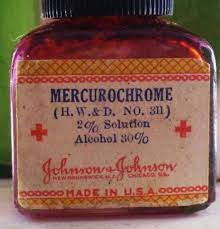November 2023
Can you spot the error in this funny internet meme? I only noticed it thanks to personal experience with two forms of this once-popular antiseptic which was banned in the USA a quarter-century ago.

I won’t keep you in suspense: that is a bottle of the aqueous solution of Mercurochrome. Crazy Mr. Morgan, my high school chemistry teacher, taught me that aqueous solutions have water as the solvent, and since the active ingredient, merbromin, was dissolved in water in that bottle instead of alcohol, the pictured antiseptic didn’t actually sting. The “fiery spit of Satan” was earlier forms of Mercurochrome that were tinctures of alcohol or acetone.
When as I child I cut myself badly enough, my father would open the first aid kit he had received in the army during World War II and apply an alcohol tincture of Mercurochrome. It certainly stung and also left a bright red stain. Some kids called it “monkey blood”, but I just knew it as painful protection against infection.
I remember later getting cut while at our vacation cabin in Missouri, and my father getting a bottle of Mercurochrome out of the bathroom medicine cabinet, which still had items left behind by the previous owners. I tearfully submitted to its application, prepared for a sting. He smeared the red stuff on, but the sting didn’t come.
I was baffled and asked him why it didn’t hurt. He shrugged, speculating that maybe it was too old and had lost its efficacy. What he didn’t realize was that the newer formulation was an aqueous solution. Being water-based, it lacked the alcohol that made his old kit form pack a punch. Alcohol contains ethanol and hydrogen peroxide, which activate receptors in the body that trigger a burning sensation. That burning sensation is a valid warning: such solutions kill germs, but they also harm the surrounding tissue of the wound, which can delay healing.

Another point of confusion is Merthiolate versus Mercurochrome. Mercurochrome was a trade name for a solution of merbromin, a compound of mercury and bromine. Merthiolate (which my parents pronounced without its “r”) was a trade name for thimerosal, a compound of mercury and sodium. Both kill some disease-causing microbes by breaking chemical bonds in proteins. Merthiolate was a tincture of alcohol or acetone, so it always stung when applied to open wounds.
In 1998, the Food & Drug Administration, concerned about the mercury in it, reclassified merbromin from “generally recognized as safe” to “untested” and that effectively banned it in the USA. To put it back on the market here in its original form would require testing and approval. Drug companies won’t pursue that expense since the drug is too old to be patented…they couldn’t recoup the testing and approval costs, since if it were eventually approved, cheap generic forms would immediately flood the market.
Thimerosal was also banned in over-the-counter products, but it is still commonly used as a preservative in various substances. Something branded as Merthiolate is still around, but it no longer contains thimerosal. Mercurochrome with merbromin is still widely available in other countries, but if you need a topical antiseptic I advise using Neosporin.
Another painful antiseptic of old, which my mother once kept on hand, was iodine. My father’s World War II first aid kit had also included some iodine swabs, but they had dried out, while Mom kept a blue bottle of iodine up in a high cabinet. It was a tincture using ethanol, so it stung when applied to a wound.
Iodine has been used as an antiseptic for over 150 years, although it has fallen out of favor for home use, despite being reportedly as effective as other antiseptic agents.
The inaccuracies in most of the internet memes I have seen about Mercurochrome brings to mind how consumers wasted over a billion dollars each year on oral phenylephrine, which some scientists and many pharamacists have known for decades was ineffective. Phenylephrine works fine in a nasal spray, but it is no better than a placebo when taken orally.
Thankfully I long ago had figured out that taking phenylephrine orally did not work for me and learned to rely on pseudoephedrine instead, despite the annoying restrictions on procuring it which were intended to fight methamphetamine addiction.
I was also quick to catch on that loratidine (aka Claratin) isn’t an effective decongestant, although it can help with other allergy symptoms. Thankfully I figured out that cetirizine (aka Zyrtec) works well for my particular allergy symptoms. However, I was much slower to acknowledge that guaifenesin did little for me to relieve chest congestion.
Back in 2006, the American College of Chest Physicians advised consumers with acute coughs from colds to ignore over-the-counter drugs with dextromethorphan or guaifenesin. If you think drugs with those ingredients are helpful, it’s your money and maybe they help with your symptoms and not mine, but you also might just be paying for placebo effects. As for homeopathic medicines, I’ll let James Randi address that quackery.
In my youth, similar nonsense was spread about vitamins. There is no substantial evidence of a health benefit for most of the adult population from taking a daily multivitamin. Yet I, like over 40% of the adults in the USA, still take one. Why is that?
For me, it is a combination of the halo effect, a lack of standards, and, most importantly, that prescription is far more convenient than proscription. The halo effect arises because we know that vitamins could indeed prevent pellagra, rickets, and scurvy back when nutritional deficiencies were common. The truth, however, is that few of us now have such poor diets that we might succumb to a disease caused by a vitamin deficit.
My innate skepticism and reading of James Randi and Martin Gardner protected me from trusting Linus Pauling, a two-time Nobel Laureate and famous chemist, who believed that Vitamin C could prevent cancer and increase the life expectancy of cancer patients. Realizing that chemistry is not medicine and that science is more than scientists, I was not surprised to find that three subsequent double-blind placebo-controlled randomized trials, sponsored by the National Cancer Institute and conducted in the Mayo Clinic, found no benefit. It sure looks like vitamin C doesn’t help much with the common cold, either. As the old saying goes, “If something is too good to be true, it probably is.”
However, few seek out rigorous research, instead relying on advertising and anecdotes or falling victim to pseudoscience. It doesn’t help that the USA does not require human research to prove that supplements are safe or effective. The FDA can stop the distribution of unsafe supplements, but they do not subject them to the scrutiny they apply to pharmaceuticals, so they escape even belated corrective actions like what is finally happening with oral phenylephrine. Throughout my lifetime the pharmacy counters have swollen with bottles of vitamins and supplements, and nowadays we have a flood of “essential oils” in the marketplace.
So why, then, do I still take a daily multivitamin? Because I know that one vitamin won’t hurt me, and my diet is far from ideal. I’d rather prescribe myself a useless vitamin than proscribe unhealthy foods I enjoy like pizza and hamburgers, and I fail to make the effort to consume more fruits and vegetables. Like you, I tend to be illogical at times, and I often prefer balms of comfort over the sting of truth.











Merbromin (the generic name of Mercurochrome) is still cheaply available outside the US, which means you can order it on Amazon or eBay. It still works great, and a bottle lasts a lifetime. The only reason it’s no longer available in the US is that there’s no profit in it.